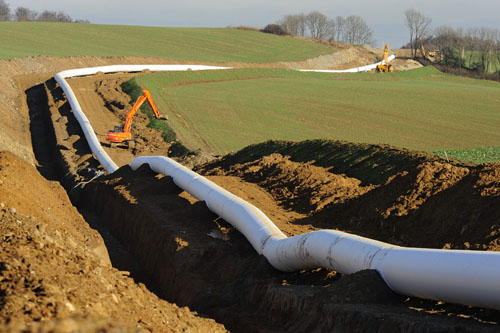
Moscow and European Commission Negotiate Over OPAL Gas Pipeline
Publication: Eurasia Daily Monitor Volume: 11 Issue: 20
By:

The European Union–Russia biannual summit, postponed from December 2013 and held on January 28, 2014, and reduced to three hours instead of the customary one and a half or two days, perforce omitted energy from its agenda. The severely abbreviated summit in Brussels had to concentrate on the politics of Ukraine. Yet Gazprom is pressing to expand and legalize its infrastructure holdings through joint companies in Germany and the South Stream project, with the Kremlin’s political support.
Russian President Vladimir Putin declared at the concluding joint conference that the EU has “in principle” agreed to allow Gazprom to use 100 percent of the OPAL pipeline’s capacity in Germany. The EU’s leaders kept silent to this (Interfax, EurActiv, January 29). Gazprom’s Vice-President Aleksandr Medvedev (involved in negotiations with the EU on this matter) stated the same on television in Moscow (RIA Novosti, January 30). A spokesperson for the European Commission informed Jamestown that the Commission has, also in principle, until March 10 to adopt its decision on OPAL (see EDM, January 30). Indeed, EU–Russia negotiations on this matter are approaching completion. The Russian side has resisted EU attempts to de-monopolize the use of OPAL.
OPAL is the largest-capacity overland gas pipeline in Western Europe, designed to pump 35 billion cubic meters (bcm) of Russian gas per year. OPAL and the 20 bcm NEL pipeline are planned to take Russian gas from the Gazprom-controlled Nord Stream pipelines on the Baltic seabed, and carry those volumes inland into Germany. OPAL’s and NEL’s combined capacities of 55 bcm per year exactly match the combined capacities of the Nord Stream One and Nord Stream Two pipelines, each designed for 27.5 bcm per year. Those matching capacities show that OPAL and NEL are fully dedicated to carrying Nord Stream gas, and moreover to be the only direct takers of Nord Stream gas into Germany and potentially beyond. The intent to lock the market in and lock competitors out could hardly be more apparent.
OPAL (“Baltic Pipeline Connector”) and NEL (“North German/European Gas Pipeline”) were completed in 2011 and 2013, respectively, by the Wintershall-Gazprom joint company WINGAS (renamed W & G, for Wintershall & Gazprom). Gazprom recently took over full ownership of WINGAS (see EDM, January 17, 20). But, prior to that takeover, Gazprom and Wintershall had spun off their pipeline holdings from WINGAS into a newly created company, Gascade Gastransport. Jointly owned by Gazprom and Wintershall on a parity basis, Gascade Gastransport operates the transmission pipelines that WINGAS had previously built throughout Germany, including OPAL and NEL.
OPAL and NEL both originate on the Baltic coast at Lubmin (near Greifswald), the landfall point of Nord Stream. Their commissioning dates (see above) were correlated with those of Nord Stream One and Nord Stream Two, which were completed in 2011 and 2012, respectively. OPAL and NEL connect Nord Stream with major transmission pipelines in Germany’s interior, including Gascade-controlled pipelines. Those carry both Russian and non-Russian gas within Germany.
OPAL runs 470 kilometers, from the Baltic coast southward to the German-Czech border. Gascade holds 80-percent ownership and the operating rights in OPAL, with E.ON Ruhrgas holding 20 percent of the shares. NEL runs 440 kilometers from the Baltic coast westward toward Hamburg, continuing to the Rehden underground gas storage site (Western Europe’s largest, recently taken over by Gazprom’s subsidiary Astora) and toward the Netherlands border. Gascade holds 51 percent ownership and the operating rights in NEL, with Nederlandse Gasunie and Belgian Fluxys holding 25 percent and 24 percent, respectively. The construction costs are estimated at about $1.3 billion for OPAL, and about the same for NEL (www.wingas.de; www.gascade.de).
The status of OPAL is currently in dispute between the Russian government and the European Commission. Negotiations have been ongoing since 2012. The Commission does not seem to contest Gazprom’s co-ownership and operation (via a subsidiary joint company) of OPAL, although the Commission might have required ownership unbundling as per the Third Legislative Package. Under that legislation, however, the European Commission requires Gazprom to make available 50 percent of OPAL’s capacity to third-party gas suppliers, thereby in effect restricting Gazprom’s use of OPAL to 50 percent of the capacity. The Commission clearly intends to de-monopolize the pipeline and the market it serves.
For its part, Moscow has long argued (as a premise) that no competing third-party gas supplier is in sight anyway, obviating the need to set aside 50 percent of capacity for a hypothetical third-party while restricting Gazprom to the remaining 50 percent. Second, Gazprom has claimed, that OPAL and NEL are equivalent to trans-border pipelines, onshore continuations of the offshore Nord Stream. This argument attempted to contest the European Commission’s jurisdiction over pipelines in EU territory. The Commission has rejected this claim out of hand, and Moscow has come to accept European jurisdiction (WirtschaftsBlatt, July 30; EurActiv, September 17, RIA Novosti, November 19, 2013; www.opal.gastransport.de, accessed January 30).
Moscow has argued, thirdly, that using OPAL (or NEL) below capacity ipso facto means below-capacity use of Nord Stream, given that OPAL and NEL and the only available outlets from Nord Stream inland, their combined capacity exactly matching Nord Stream’s (see above). As a result, shareholders in all these pipelines forfeit part of the revenue from gas sales, must subsidize the incomplete use of pipelines, and prolong the period of amortization of the pipelines’ construction costs. These arguments are partly undermined by Gazprom’s own practice of booking full capacities of pipelines under its control, even if it does not use them at full capacity. In some cases Gazprom plans the under-utilization in advance. However, Gazprom’s minority partners in Nord Stream—namely, Wintershall and E.On Ruhrgas with 15.5 percent each, and Nederlandse Gasunie and Gaz de France with 9 percent each—must be very keen to see the soonest possible negotiated solution with the European Commission (RIA Novosti, January 23; www.naturalgaseurope.com, accessed January 30; see EDM, January 30).




